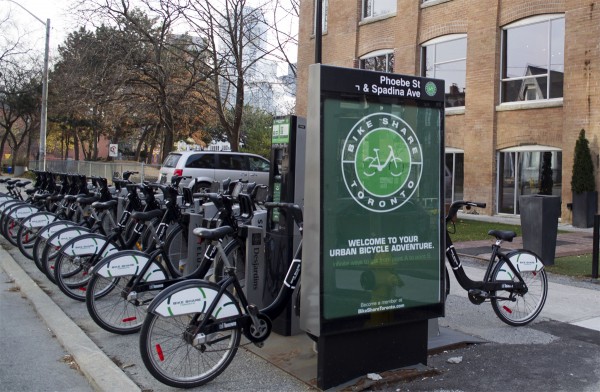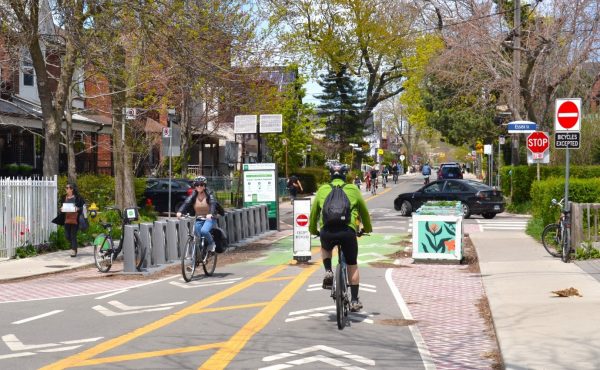As a long-standing Bike Share Toronto member, I was excited to read that the Ontario government is investing in additional bikes and an expansion of the network. And as a cities/infrastructure nerd, I of course immediately started drawing dots on maps and chatting with anyone who will listen about where new Bike Share stations should be placed and how to get more people using the network.
According to the Metrolinx media release, the new docking stations and bikes “will be located close to transit stations and in dense areas where demand is likely to be strong, which helps connect users to transit in the first and last kilometres of their journeys.” Placing bikes near transit stations is clearly a good idea, but more will need to be done in order to get people off of trains and onto bikes. Improved on-street cycling infrastructure will play a major role, but there’s another factor: Bike Share Toronto has never been marketed as a commuting option.
At the program’s outset, many stations were placed seemingly to benefit tourists. Later, then-owner Bixi ran an ad campaign that pitched bike sharing as way to hop from one social destination to another — which always struck me as only slightly better than the cycling strategy Rob Ford published in 2010, which depicted cycling as a purely trail-based recreational activity. There are many possible reasons why Bike Share Toronto is marketed in this manner. Perhaps the Toronto Parking Authority, like the program’s previous administrator, figures that anyone who wants to commute to work on a bike is already doing so. It might also be the limited range of the network, or the fact that commuters’ unidirectional nature would create bike-distribution hassles.
Yet despite all this, many Bike Share Toronto members use the system to get to and from work — often in combination with public transit. If this is indeed the kind of user Metrolinx and the City intend to attract by putting more bikes outside of subway stations, their way forward is clear: Think of bike sharing as an inexpensive, modular, smaller-scale version of the downtown relief line, and act accordingly. Prioritize installing — and maintaining bike supply — at stations on Line 2 that encourage people travelling east and west to disembark before Bloor-Yonge or St. George, and instead grab a bike for those aforementioned “first and last kilometres of their journeys.”
But then — and this is crucial — support this effort with bike lanes, and foster it with marketing that shows how bike sharing can become a vital part of a subway rider’s daily transit mix in general, and as a savvy way to bypass the downtown stations of Line 1 in particular. Because, though bike sharing is by no means the sole solution to transit overcrowding, Toronto’s program has a wealth of untapped potential. All that’s needed, along with this new investment, is a strategic shift in how Bike Share Toronto is viewed — by its administrators, and its thousands of potential members.
Photo by Amanda N Sherrington





4 comments
I have been saying this since day 1. The Bixi rollout as small as it was limited the number of stations and bikes at important locations.
– Needs to be at all subway stations, and near to at least 1/2 of all streetcar stops
– Needs to be at all major tourist locations with enough spots to support the demand during events (i.e. skydome)
– Needs to be at the beginning and end of all major bike lanes, and at certain intervals along the way
– Needs to be on the island
– Needs to be near major parking lots
– Outlying stations at important places that are distant from the core – Ex, Zoo, Science Centre, Beaches, Humber cycling bridge (with appropriate allowances for time to get to them)
– There should be a way for BIA’s, residents associations, employers and community groups to fund their own station if expansion to their area is not likely
The number one example I have of how ridiculous the current system is – there is a station at Jarvis and Bloor…which was perfect when there was bike lanes on Jarvis…but now that there isn’t bike lanes it should be moved to Sherbourne so that it is next to the subway station and the separated bike lanes…yet it’s still at Jarvis…how is this convenient to anyone?
Todd,
Maybe you can help me out. Why is this a government financed activity, instead of government permitted/licensed like taxis? There seems such a desperate need for better thought going into to help grow what seems to be a good kernel of an idea: why isn’t government just facilitating private sector players to figure out what works best?
Is this fundamentally a money loser, so only government will bother invest in it? If not, why are private sector players being excluded? It can’t be that expensive to set up and maintain.
I saw a report on Bixi/Bikeshare trips – one of the heaviest routes was from the Fort York/Railway Lands area to the financial district – a trip that doesn’t have a really convenient transit route. Another was from Union Station and other locations to Ryerson. It was pretty clear people were using them to commute – either a) from places like small condos where owning a bike is inconvenient, on routes without direct transit, or b) as you are advocating, as the last kilometre of a trip by transit.
Using the data the Toronto Parking Authority uses to locate and price car parking would seem to be one avenue to take. After all, TPA is supposed to be building parking near where people are trying to get. Look at those numbers and repurpose Green P spots or street parking spots where there’s measurable demand.
Also, can we please either fix the grid near bike share stations or move them from weird spots on one-way streets? E.g. there’s one south of Dundas on Simcoe right next to Toronto Police’s 52 Division, but Simcoe is one-way the wrong way to get to it! Contra-flow that already!